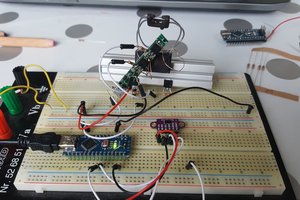Zephyr is two rather simple parts that work together. The first part is an anemometer, the second is a chime synthesizer.
The hardest part about the anemometer is actually obtaining or building one inexpensively. An anemometer is a wind speed measuring device. For our purposes, we don't care about calibrating it, we just want a simple relative speed indication. The easiest way to accomplish that is to use a cup-style rotating anemometer with a magnet mounted on the rotating part such that the magnet passes near a magnet sensor at least once per revolution (a magnet mounted on each rotating arm will provide more resolution). The sensor will effectively give us a leading edge every time it sees a magnet come near (good sensors have hysteresis to avoid false triggering).
The chime synthesizer simply needs to play a note for every leading edge it sees, but that note should be randomly selected and the synthesizer needs to be able to play at least two notes simultaneously in order to sound like a natural wind chime.
Making an interesting sounding wind chime is a lot like making an interesting sounding train horn. It's all about the notes you select. In the case of a wind chime, traditional choices include the whole-tone scale or an arpeggiated chord. Other good choices are the blues scale (so your chimes sound like a blues solo) or a major seventh chord.
 Nick Sayer
Nick Sayer
 ARISTIDES Alexandre
ARISTIDES Alexandre

 J. M. Hopkins
J. M. Hopkins
 David
David